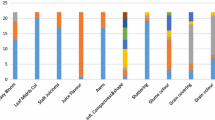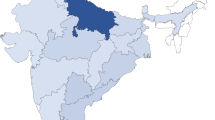Abstract
Foxtail millet [Setaria italica (L.) P. Beauv.] is among the oldest cereal grains grown from time immemorial in the Himalayan regions of Nepal. However, Nepalese farmers do not have any improved variety officially released due to lack of substantial research in this crop. A total of 41 foxtail millet accessions were characterized using phenotypic or morphological markers at National Agriculture Genetic Resources Centre (Genebank), Khumaltar (1360 m a.s.l.), Lalitpur, Nepal during 2015 summer to enhance the utilization of foxtail millet genetic resources. Seven quantitative and nine qualitative traits were recorded using standard descriptors of foxtail millet to assess the intra-specific diversity. Significant diversity was observed among the accessions as revealed by Shannon–Weaver diversity indices (H′) for quantitative traits and qualitative traits. Six elite landraces in Cluster-4 and Cluster-5 (three from Lamjung district, and one each from Gorkha, Humla and Jumla districts) produced average grain yield of 3136 kg/ha at Khumaltar condition with earlier maturity (average of 89 days), taller height (average of 172 cm) and thicker panicles (average width of 27 mm). These landraces were selected for further evaluation in the farmers’ field of mountain region due to their early maturity, higher yield potential, disease resistance and attractive panicles which could be considered as important genetic resources to develop climate resilient varieties to cope with the adverse effects of climate change.




Similar content being viewed by others
References
Amgai RB, Pantha S, Chhetri TB, Budhathoki SK, Khatiwada SP, Mudwari A (2011) Variation on agro-morphological traits in Nepalese foxtail millet (Setaria italica (L.) P. Beauv.). Agron J Nepal 2:2011
Bisht IS, Rao KS, Bhandari DC, Nautiyal S, Maikhuri RK (2006) A suitable site for in situ (on-farm) management of plant diversity in traditional agroecosystems of western Himalaya in Uttaranchal state: a case study. Genet Resour Crop Evol 53:1333–1350. https://doi.org/10.1007/s1022-005-4432-5
de Wet JME, Oestry-Stidd LL, Cubero JI (1979) Origins and evolution of foxtail millets (Setaria italica). Journ d’Agric Trad et de Bota Appl XXVI(1):53–64
Goron TL, Raizada MN (2015) Genetic diversity and genomic resources available for the small millet crops to accelerate a new green revolution. Rev Front Plant Sci 6:1–17. https://doi.org/10.3389/fpls.2015.00157
Gurung R, Sthapit SR, Gauchan D, Joshi BK, Sthapit BR (2016) Baseline Survey Report: II. Ghanpokhara, Lamjung. Integrating traditional crop genetic diversity into technology: using a biodiversity portfolio approach to buffer against unpredictable environmental change in the Nepal Himalayas. LI-BIRD, NARC and Bioversity International, Pokhara, Nepal
Hammer K, Khosbhakht K (2007) Foxtail millet (Setaria italica (L.) P. Beauv.) in Mazandaran/Northern Iran. Genet Resour Crop Evol 54:907–911. https://doi.org/10.1007/s10722-007-9211-z
Hammer K, Knüpffer H, Laghetti G, Perrino P (1999) Seeds from the past. A catalogue of crop germplasm in the Central and North Italy, IdG, Bari
Hodgkin T, Ramanatha Rao V, Cibrian-Jaramillo A, Gaiji S (2003) The use of ex situ conserved plant genetic resources. Plant Genet Resour 1(1):19–29. https://doi.org/10.1079/PGR200313
IBPGR (1985) Descriptors for Setaria italica and S. pumila. International Board for Plant Genetic Resources, Rome, Italy
Joshi KD, Sthapit BR (1990) Informal research and development (IRD): a new approach to research and extension. LARC Discussion Paper 1990/4, Lumle, Pokhara, Nepal
Kumari R, Dikshit N, Sharma D, Bhat KV (2011) Analysis of molecular genetic diversity in a representative collection of foxtail millet [Setaria italica (L.) P. Beauv.] from different agro-ecological regions of India. Physiol Mol Biol Plants 17(4):363–374. https://doi.org/10.1007/s12298-011-0085-3
Li J, Wu SZ (1996) Traditional maintenance and multiplication of foxtail millet (Setaria italica (L.) P. Beauv.) in China. Euphytica 87:33–38
Mo FSC (2002) Nepal biodiversity strategy. Ministry of Forests and Soil Conservation, HMG, Nepal
Nakayama H, Namai H, Okuno K (1999) Geographical variation of the alleles at the two prolamin loci, Pro1 and Pro2, in foxtail millet, Setaria italica (L.) P. Beauv. Genes Genet Syst 74:293–297
Ning N, Yuan X, Dong S, Wen Y, Gao Z, Guo M, Guo P (2015) Grain yield and quality of foxtail millet (Setaria italica L.) in response to tribenuron-methyl. PLoS ONE 10(11):e0142557. https://doi.org/10.1371/journal.pone.0142557
Palikhey E, Sthapit SR, Gautam, S, Gauchan D, Joshi BK, Sthapit BR (2016) Baseline Survey Report: III. Haku, Jumla. Integrating traditional crop genetic diversity into technology: using a biodiversity portfolio approach to buffer against unpredictable environmental change in the Nepal Himalayas. LI-BIRD, NARC and Bioversity International, Pokhara, Nepal
Parajuli A, Subedi A, Sthapit SR, Gauchan D, Adhikari A, Joshi BK, Sthapit BR (2017) Baseline Survey Report: IV. Chhipra, Humla. Integrating traditional crop genetic diversity into technology: using a biodiversity portfolio approach to buffer against unpredictable environmental change in the Nepal Himalayas. LI-BIRD, NARC, DOA and Bioversity International, Pokhara, Nepal
Reddy VG, Upadhyaya HD, Gowda CLL (2006) Characterization of world’s foxtail millet germplasm collections for morphological traits. ISMN 47:107–109
Saha D, Channabyre Gowda MV, Arya L, Verma M, Bansal KC (2016) Genetic and genomic resources of small millets. Crit Rev Plant Sci 35:56–79. https://doi.org/10.1080/07352689.2016.1147907
Saud NB (2010) Crops of Nepal and their sustainable farming (in Nepali, Nepalka balinali ra tinko digo kheti). Sajha Prakashan, Pulchok, Lalitpur, Nepal, pp 223–227
Scheibe A (1943) Die Hirsen im Hindukush. Eine Beitrag zur Kenntnis von Kulturpflanzen in geographischer Rückzugsposition. Z Pflanzenzüchtg 25:392–436
Shannon CE, Weaver W (1949) The mathematical theory of communication. The University of Illinois, Chicago, pp 3–24
Sheikh SM, Singh O (2013) Pseudocereals and millets: the lost crops of Kashmir. Genet Resour Crop Evol 60:1191–1199
Stevens CJ, Murphy C, Roberts R, Lucas L, Silva F, Fuller DQ (2016) Between China and South Asia: a middle Asian corridor of crop dispersal and agricultural innovation in the Bronze Age. The Holocene 26(10):1541–1555. https://doi.org/10.1177/0959683616650268
Sthapit BR, Ramanatha Rao V (2009) Consolidating community’s role in local crop development by promoting farmer innovation to maximise the use of local crop diversity for the well-being of people. Acta Hort 806:669–676
Vavilov NI (ed) (1926) Centers of origin of cultivated plants. In Origin and geography of cultivated plants. Cambridge University Press
Witcombe JR, Khadka K, Puri RR, Khanal N, Sapkota A, Joshi KD (2016) Adoption of rice varieties. 2. Accelerating uptake. Exp Agric. https://doi.org/10.1017/s0014479716000624
Xiaomei F, Dong K, Wang X, Liu T, He J, Ren R, Zhang L, Liu R, Liu X, Li M, Huang M, Zhang Z, Yang Y (2016) A high density genetic map and QTL for agronomic and yield traits in foxtail millet [Setaria italica (L.) P. Beauv.]. BMC Genom 17:336. https://doi.org/10.1186/s12864-016-2628-z
Zhang S, Tang C, Zhao Q, Li J, Yang L, Qie L, Fan X, Li L, Zhang N, Zhao M, Liu X, Chai Y, Zhang X, Wang H, Li Y, Li W, Zhi H, Jia G, Diao X (2014) Development of highly polymorphic simple sequence repeat markers using genome-wide microsatellite variant analysis in foxtail millet [Setaria italica (L.) P. Beauv.]. BMC Genom 15:78. https://doi.org/10.1186/1471-2164-15-78
Zohary D, Hopf M, Weiss E (2012) Domestication of plants in the Old World. Oxford University Press, Oxford
Acknowledgements
This paper is the output of the GEF/UNEP supported project, “Integrating Traditional Crop Genetic Diversity into Technology: Using a Biodiversity Portfolio Approach to Buffer against Unpredictable Environmental Change in the Nepal Himalayas” implemented in Nepal. The project is coordinated by the Bioversity International in collaboration with Nepal Agricultural Research Council (NARC), Department of Agriculture (DoA) and Local Initiatives for Biodiversity Research and Development (LI-BIRD). Field and technical support of Mr. M.R. Bhatta, Mr. M. Bhattarai and Dr. M.N. Paudel (NAGRC), Dr. D. Jarvis and Dr. D. Gauchan (Bioversity International) are gratefully acknowledged.
Author information
Authors and Affiliations
Corresponding author
Ethics declarations
Conflicts of interest
There are no conflicts of interests to be declared.
Rights and permissions
About this article
Cite this article
Ghimire, K.H., Joshi, B.K., Gurung, R. et al. Nepalese foxtail millet [Setaria italica (L.) P. Beauv.] genetic diversity revealed by morphological markers. Genet Resour Crop Evol 65, 1147–1157 (2018). https://doi.org/10.1007/s10722-017-0602-5
Received:
Accepted:
Published:
Issue Date:
DOI: https://doi.org/10.1007/s10722-017-0602-5




